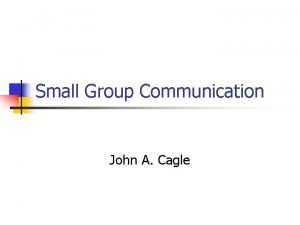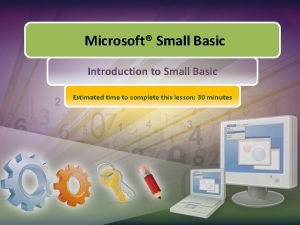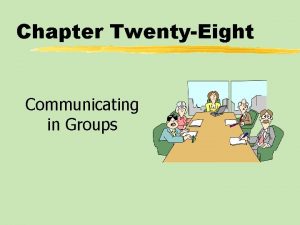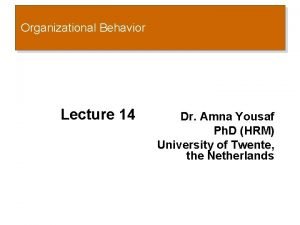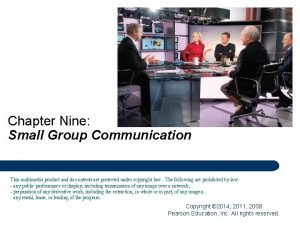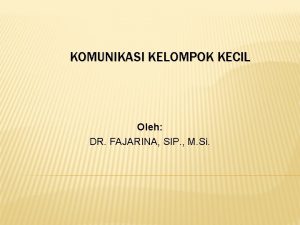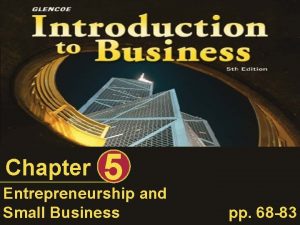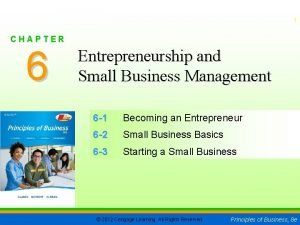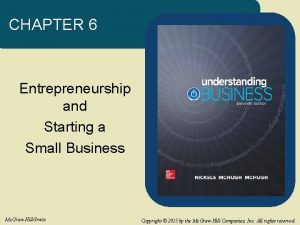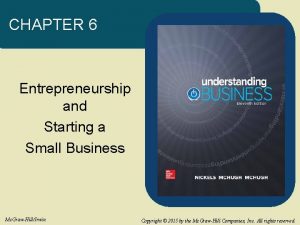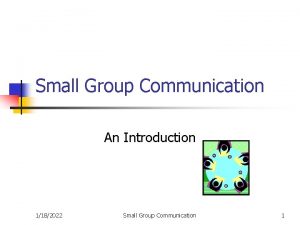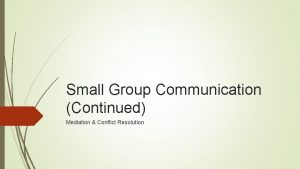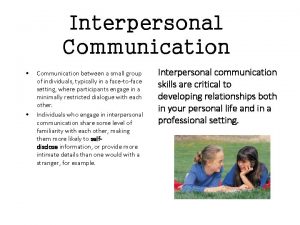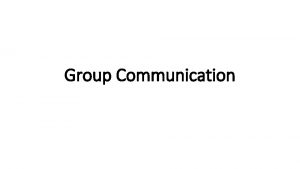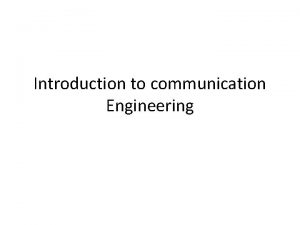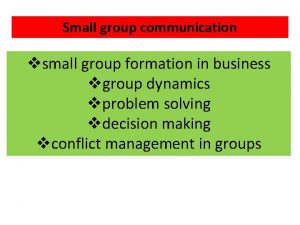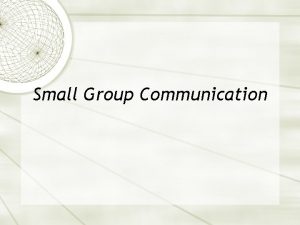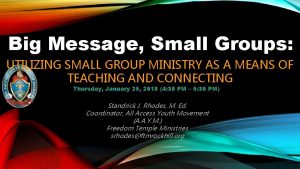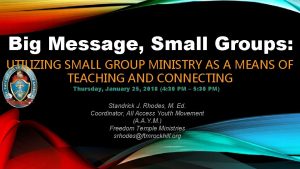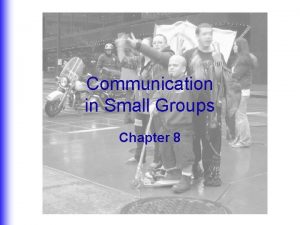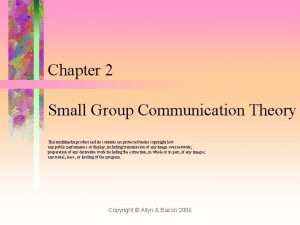Chapter 20 Group Communication Group Communication Introduction Small

































- Slides: 33

Chapter 20 Group Communication

Group Communication: Introduction • Small group: Limited number of people gathered for a specific purpose • Group dynamics: The ways in which members relate to one another and view their functions – Can determine whether a group achieves its mission

Group Communication: Introduction (cont. ) • Small groups offer important advantages over individual efforts. – People can often achieve a better outcome through collaboration than by working alone. – Each group member has unique experiences and perspectives to offer. – The group can divide a project so that each member takes responsibility for the portions of the job that he or she is best suited for.

Effective Group Leadership • Selecting a Leader – Groups gain leaders in various ways: • Designated leader selected by an external authority • Implied leader with preexisting authority or skills particularly well suited to the task at hand • Emergent leader who comes to be recognized as a leader by the group’s members over time

Effective Group Leadership (cont. )

Effective Group Leadership (cont. ) • Leading Meetings – Address procedural needs. • When and where will meetings take place? • Who will start meetings and record notes? • How will notes get circulated?

Effective Group Leadership (cont. ) – Model the behavior you expect. • Avoid interrupting others or dismissing their questions or comments. • Do not dominate discussions or decisions.

Effective Group Leadership (cont. ) – Facilitate discussion. • Ensure that all members of your group have the opportunity to participate in each discussion.

Effective Group Leadership (cont. ) – Keep members on task in a friendly manner.

Effective Group Leadership (cont. ) – Help members avoid groupthink, the tendency to accept ideas and information uncritically because of strong feelings of loyalty or single-mindedness within the group. • Groupthink erodes the lively and open exchange of ideas necessary for informed decisions. • It also suggests that being increasingly amiable with other members of a group can decrease independent, critical thinking and replace it with groupthink.

Effective Group Leadership (cont. )

Effective Group Leadership (cont. ) – Facilitate decisions. • When group members have thoroughly discussed the issue at hand, help them come to a decision. • Never use your power to manipulate the group.

Effective Group Leadership (cont. ) • Managing Conflict – Help organize the group’s presentation. • You don’t necessarily need to make all the decisions yourself, but you do need to coordinate the decisions to be made.

Effective Group Leadership (cont. ) – Refer to ideas by topic, not by person. • Focus on the content of specific suggestions rather than attributing those suggestions to individual members. • When ideas get associated with an individual, that person may become defensive if the proposal is criticized, even if it has real shortcomings.

Effective Group Leadership (cont. ) – Resolve conflicts quickly. • Try to resolve distracting conflicts rather than allowing them to continue or repressing them. • Give each disagreeing member an equal opportunity to explain his or her perspective. • You may ultimately need to offer your opinion or vote in order to break a deadlock on an issue.

Effective Group Leadership (cont. ) – Focus on tasks, not disagreements. • Articulate desired changes in behavior rather than criticizing individuals. • A personality clash may better be solved by discussing the problem in private with the members who disagree.

Effective Group Leadership (cont. ) – Manage disruptive emotions. • Even after a conflict has been resolved, members may still feel angry, upset, or embarrassed, and may withdraw from the group. • Bring reluctant members back into the discussion by inviting their input on important issues.

Effective Group Membership • Three types of member roles: – Task-oriented roles • Initiators suggest the group’s goals and offer new ideas or propose new solutions. • Information providers offer facts relevant to the issue under discussion. • Information gatherers ask other members to share facts they know, or they seek out needed information from other sources.

Effective Group Membership (cont. ) • Elaborators add supporting facts, examples, or ideas to a point that someone else has made during the discussion. • Clarifiers attempt to make the meaning of another member’s statement more precise. • Evaluators offer their own judgments about the ideas put forward during a discussion. • Synthesizers identify emerging agreements and disagreements among the group as a whole. • Recorders take notes during the meeting, tracking major decisions and plans made by the group.

Effective Group Membership (cont. )

Effective Group Membership (cont. ) – Maintenance-oriented roles • Harmonizers decrease tension in the group. • Compromisers attempt to find common ground between adversaries within the group, and offer solutions that may be palatable to both sides. • Encouragers inspire other group members by complimenting their ideas and work. • Gatekeepers facilitate the exchange of information among group members. • Norm facilitators reinforce healthy group norms and discourage unproductive ones.

Effective Group Membership (cont. )

Effective Group Membership (cont. ) – Self-oriented roles • Blockers stop the group from moving toward its objective by refusing to accept group decisions or the opinions and ideas of other group members. • Withdrawers refuse to make any contribution or to participate in the discussion. • Dominators monopolize group interactions. • Distracters—the exact opposite of harmonizers— send the group in irrelevant directions with off-topic comments or extraneous conversation.

Effective Group Membership (cont. )

Effective Group Membership (cont. ) • Tips for Participating in a Small Group – Prepare for group meetings. – Treat other members courteously. – Listen interactively. – Participate, don’t dominate. – Participate authentically. – Fulfill your commitments.

Group Decision Making and the Reflective-Thinking Process • Reflective-thinking process – Particularly effective approach to making a group decision – Five steps: • • • Define the problem. Analyze the problem. Establish criteria for solutions. Generate possible solutions. Select the best solution.

Group Decision Making and the Reflective-Thinking Process (cont. )

Delivering Group Presentations • Symposium – Several or all group members speak to the audience in turn. – Plan carefully and systematically by agreeing on which topic each member will address, how she or he will present it, and how much time is available. – Each speaker should introduce and provide a transition to the next speaker.

Delivering Group Presentations (cont. ) – Organize the symposium as you would an individual speech by including an introduction, body, and conclusion. • Have the first speaker also give the introduction. • Have the final speaker present a conclusion summarizing each presenter’s main idea.

Delivering Group Presentations (cont. ) • Panel discussion – Group members converse among themselves at a table while the audience watches and listens. – A panel requires a moderator who: • • Introduces panelists Leads group discussion and monitors time Ensures that each panel member participates May participate in the discussion

Delivering Group Presentations (cont. ) – Panel members should: • Participate in the discussion • Give each other an opportunity to talk • Be tactful and professional when disagreeing with another panelist – Atmosphere is usually more casual than in a symposium. • Talk about the panel discussion in advance with your group so that you all know which questions or topics you want to bring up.

Delivering Group Presentations (cont. ) • Single group representative – One person is responsible for presenting on behalf of an entire group. • Check that the group has decided on the best approach to the presentation. • Be sure that all group members have input. • As the speaker, distinguish whether you are representing your own views, those of some members of the group, or a consensus of all group members.

Delivering Group Presentations (cont. )
 An introduction to group communication
An introduction to group communication Dewey's reflective thinking process
Dewey's reflective thinking process Introduction to small basic
Introduction to small basic A small group usually has between three and twenty people.
A small group usually has between three and twenty people. Small group dynamics
Small group dynamics Low channel richness
Low channel richness Small group tutoring
Small group tutoring Small caring group
Small caring group Never doubt a small group of concerned citizens
Never doubt a small group of concerned citizens Small group tutoring
Small group tutoring Formal small group networks
Formal small group networks Typical gd comprises of a small group of candidates
Typical gd comprises of a small group of candidates Small group stages formats and culture
Small group stages formats and culture Komunikasi kelompok kecil
Komunikasi kelompok kecil God of small things chapter 1
God of small things chapter 1 Chapter 6 entrepreneurship and starting a small business
Chapter 6 entrepreneurship and starting a small business Chapter 5 entrepreneurship and small business
Chapter 5 entrepreneurship and small business Chapter 5 entrepreneurship
Chapter 5 entrepreneurship Chapter 8 carburetion answers
Chapter 8 carburetion answers Entrepreneurship and small business management chapter 6
Entrepreneurship and small business management chapter 6 Joshua moore entrepreneur
Joshua moore entrepreneur Entrepreneurship and small business management chapter 1
Entrepreneurship and small business management chapter 1 Chapter 5 entrepreneurship and small business
Chapter 5 entrepreneurship and small business Chapter 6 entrepreneurship and starting a small business
Chapter 6 entrepreneurship and starting a small business Chapter 6 entrepreneurship and starting a small business
Chapter 6 entrepreneurship and starting a small business Small busness loans
Small busness loans Chapter 6 entrepreneurship and small business management
Chapter 6 entrepreneurship and small business management Introduction paragraph structure
Introduction paragraph structure Introduction of shg
Introduction of shg Group dynamics definition
Group dynamics definition Altruistic
Altruistic Within group variance vs between group
Within group variance vs between group Anova within group and between group
Anova within group and between group Voluntary group and involuntary group examples
Voluntary group and involuntary group examples

